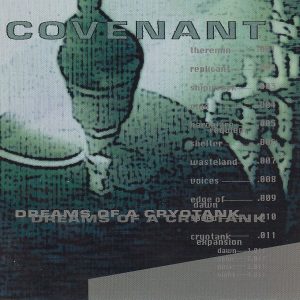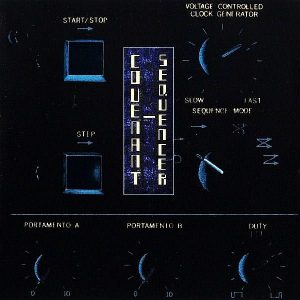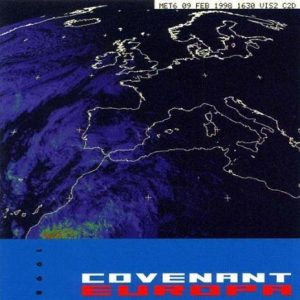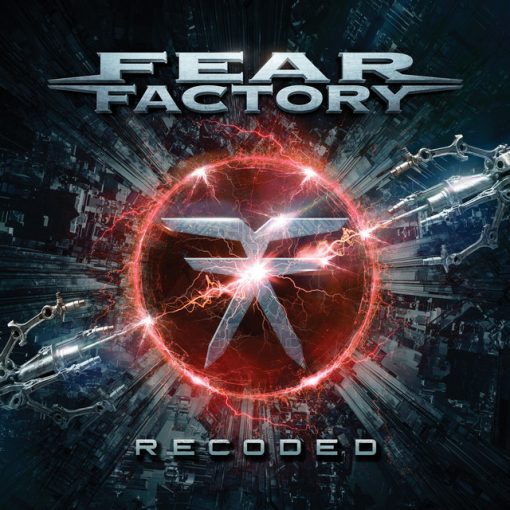My Djing is usually request friendly, with the exception of certain private bookings and some (but not all) genre-specific events. I thought I’d extend that concept to the Listeners Guides and write about a band that someone was interested in reading about. Mesh were a candidate, and may indeed follow soon if I can find some distinctive to say about their later albums. Coil was an interesting if totally-unworkable suggestion, but Covenant struck me as having the strongest case. One of the biggest names in a vast pantheon of Swedish electronic music, and, as we will see, joint innovator of a musical style that was equally loved, tolerated and reviled, but dominated scene dancefloors for many years.
A common source of confusion in the early days was the existence of a Norwegian band of the same name. Now known as ‘The Kovenant’ after various legal wrangles, the two bands are known in spoken parlance as “Covenant with a C” and “The Kovenant with a K”. So please understand that in this Definitive guide, there is no definitive ‘The’ in front of the band name. It’s just “Covenant”
Covenant Forged
Covenant came together in 1989 as a union of Eskil Simonsson, Joakim Montelius and Clas Nachmanson. The first the world would hear of them would be the track ‘Replicant’ on the Autumn Leaves compilation – actually both the song and the band were still using the definitive ‘The’ at the time, but that was soon dropped. Our story therefore begins with their debut full-length album Dreams of a Cryotank, released in 1994. Released in an era where EBM and electro-industrial boundaries were blurring more than ever, it had enough influence from the sound of the time to draw an instant fanbase, but there were enough distinctive features to make their mission statement clear. The staccato rhythms, the icy synths, the use of noise as a textural element rather than it’s usual weaponsiation, and Eskil’s vocal style, notably “cleaner” that his contemporaries.
The compilation track Replicant is here, resplendent in it’s Blade Runner referencing (always a favourite for the genre), though the stand out hit here was Theremin. A confusing title given that neither the lyrics nor the music reference said instrument or its creator, but it’s attack at the modern tendency to ‘turn a blind eye’ to the evils of the world is more relevant today than it was in the caring (?), sharing (??) 1990s. Void is another standout, though a little too close to “Tragedy >For You<” in concept. That said, early 90s 242 is a valid route into the Covenant sound, so if they had to make one influence a little too obvious, this was the right one to go for.
Wasteland and Edge of Dawn follow similar concepts – both of these tracks have their followers and the latter even gave it’s name to one of Frank Spinath’s numerous projects. The album does fall down at at numerous points – Shipwreck and Shelter both sound very ‘static’ with some very forced lyrical metaphor. The long, ambient Cryotank Expansion is one big unnecessary filler which I’ve rarely made it through. The frustrating track is Speed. It clearly screams out that it wants to be an ‘anthem’ but struggles to do so on this occasion – as if the tune doesn’t want to let Eskil’s inspired vocal break free. The definitive version comes later….
Singles and Versions: This album has been released on a number of labels with differences to the track list. Avoid the Metropolis version, it replaces the critical “Void” with the pointless “Painamplifier”. Most later versions of the album have a ‘Club Edit’ of “Theremin” at the end, a slight reworking, but you’ll have to skip or endure the “Cryotank Expansion” to get there.
Onto 1996, and Sequencer. It’s only their second full-length release, but already we’ve hit their ‘maturity of sound’ phase, making the Cryotank concepts work over a complete album. Feedback opens the album with a wall of noise from which the tune emerges, and the already the increasingly complex sound of this project is apparent. Stalker immediately marks itself as an anthem with it’s octave basslines and seamless segue from verse to chorus, and even this isn’t the pinnacle of this albums achievement. Track three is Figurehead, and it’s here we discover the first Covenant ‘epic’.
The band’s love of water-related lyrical metaphor was established here, in 2018 still a suitable analogy for those who appear to wield power whilst being unable to reap any benefits in practice. The layers of synth lap against the ‘Ship of Fools’ in a remarkably fluid manner whilst the underlying rhythm drives the song forward endlessly. Everything you need to know about early-era Covenant is encapsulated in this song, though the lengthy outro isn’t something they’ve equalled before or since. The other notable tune is Slowmotion – a downtempo piece with one of the most committed vocal performance Eskil has ever delivered – the final crescendo is one of moments where you realise what he is (or was) truly capable of. Another aspect of their sound that we wouldn’t hear again.
If I do have an issue with this album, it’s that whilst the production quality is strong throughout, the songwriting does fade from memory in the later stages, as if their unique turn of phrase began to decline towards the end. The more technical reviewers out there (for the industrial scene has many), less likely to fault the ‘artistic impression’ aspects, have sometimes gone as far as defining this as a ‘perfect album’. For me it fell slightly short as a result of the depletion of the idea pool in the very late stages. But let us continue….
Singles and Versions: Early versions of the album have an orange cover and lack the track “Luminal” – the versions with this track included are known as ‘Sequencer:Beta’. The initial US version also lacks this track, but bundles the ‘Stalker’ EP, available separately in Europe. This EP has a very different Club version of “Stalker”, replacing the octave bassline with a production style closer to “Figurehead”. There’s also a couple of exclusive tracks, with the noisy “Babel” appearing in their live sets from time to time and a favourite amongst some long-time fans, but I never got what the fuss was about.
The ‘Figurehead’ single has two of the most essential Covenant tracks of all. Both the title track and “Speed” both get significant overhauls of their own, both receiving a ‘looser’ production style that allows both tracks to escape from the tight confines of their original mixes and really fly, with the choruses of each track in particular upping the anthem quotient substantially. This single was released in the USA as the “Theremin EP”, adding a few tracks missing from the American version of ‘Cryotank’, including the club mix of “Theremin” and the essential “Void”. If you’re the kind not to bother with ‘singles’, break that rule for a moment, as one of these is essential for any Covenant collection worthy of the name.
Two years later we heard Europa, which saw the Covenant sound partway through it’s first real evolution. Tracks like Leviathan and Riot are still based around the concept of songs-emerging-from-ferocious-loops-of-noise, but there’s more evidence of a more accessible, synthpoppier production style elsewhere. One could lazily compare such synthetic melodics to Kraftwerk or the more tuneful forms of early EBM, but there’s still something distinctively Covenant going on here. The throbbing bass and muted synth chimes of Tension that open the album couldn’t have been done this way by anyone else – it’s just odd to hear a Covenant album not open up with some almighty blast of noise. They are showing more restraint, but it’s not to the detriment of the music.
I have to admit that the middle part of the album has never appealed to me, with some less-than-inspiring songwriting, the sole Clas-credited composition, ever (Wind Of The North) a definite low point. It’s the final three songs that really tell us where Covenant are heading. Final Man is their first out-and-out pop song, a sign of what was to come on the next album. Go Film is a dense, spoken-word affair with a surprisingly spiritual subject matter, and the closer Wall Of Sound is a drawn-out combination of plink-plonk synths, vocoders and tight rhythm loops. It ends an album that, like all Covenant releases, has it’s followers, even if it’s the least favoured of their early albums in subsequent live shows. It’s still an important part of their musical development, as it was the stepping stone to the sound that defined their best-known songs.
Singles and Versions: “Final Man” was released as a single with two marginal reworks and two B-side tracks, none are essential. More interesting is the 7-track “Euro EP”, with three alternate versions apiece for “Tension” and “Go Film” plus the curiosity “Consumer”. Some of these (like the Disco Calculi versions) deviate too far off into synth noodling, but more upbeat takes, like the “Hard version” of “Go Film” will be of interest to DJs in particular.





